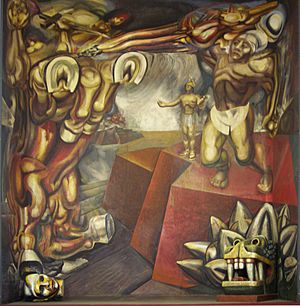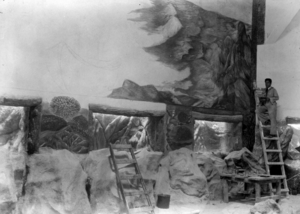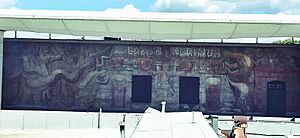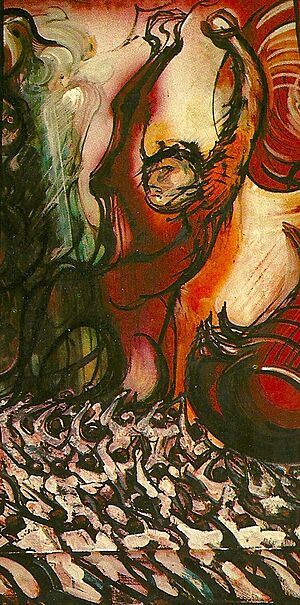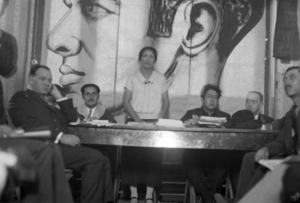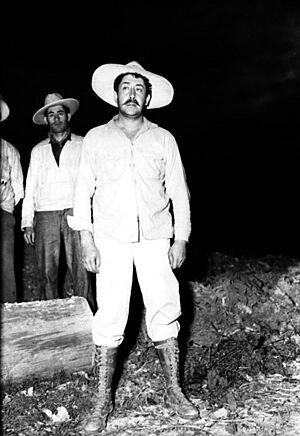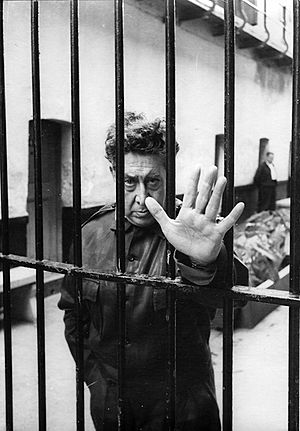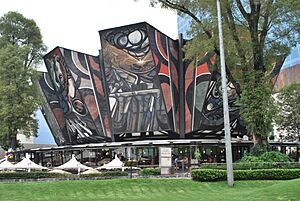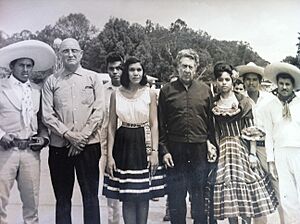David Alfaro Siqueiros facts for kids
Quick facts for kids
David Alfaro Siqueiros
|
|
|---|---|
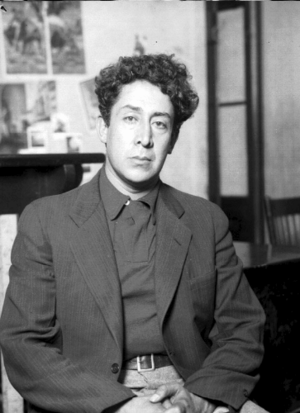
Portrait of Siqueiros, year unknown
|
|
| Born | December 29, 1896 Chihuahua, Mexico
|
| Died | January 6, 1974 (aged 77) Cuernavaca, Morelos, Mexico
|
| Nationality | Mexican |
| Education | San Carlos Academy |
| Known for | Painting, Muralist |
|
Notable work
|
Portrait of the Bourgeoisie (1939–1940), The March of Humanity (1957–1971) |
| Movement | Mexican Mural Movement, Social Realism |
| Awards | Lenin Peace Prize 1966 |
David Alfaro Siqueiros (born José de Jesús Alfaro Siqueiros; December 29, 1896 – January 6, 1974) was a famous Mexican painter. He is best known for his huge public murals. These large artworks often covered entire walls. Siqueiros used new tools and techniques for his paintings.
He was one of the most famous "Mexican muralists". The other two were Diego Rivera and José Clemente Orozco. Siqueiros believed art should help people understand important ideas. He was also involved in politics. He supported the Soviet Union and was a member of the Mexican Communist Party. He was involved in a controversial event related to Leon Trotsky in 1940.
Siqueiros used his mother's last name, Siqueiros. This is similar to how some famous artists like Pablo Picasso used their mother's name. For a long time, people thought he was born in Camargo, Chihuahua. But in 2003, his birth certificate was found. It showed he was born in the city of Chihuahua. He grew up in Irapuato, Guanajuato, from age six. He changed his first name to "David" because his first wife thought he looked like Michelangelo's famous David statue.
Contents
Early Life and Art Beginnings
Many facts about Siqueiros's childhood were unclear for a long time. This included his birth date and where he grew up. Some of these details were even misstated by Siqueiros himself. Thanks to art historian Raquel Tibol, we now know more. She found his birth certificate. It showed he was born in Chihuahua in 1896.
David was the second of three children. His father, Cipriano Alfaro, was from Irapuato and was well-off. His mother was Teresa Siqueiros. David had an older sister, Luz, and a younger brother, Jesús. When David was four, his mother died. His father sent the children to live with their grandparents. His grandfather, nicknamed "Siete Filos" (seven knife-edges), was very important in his life. In 1902, Siqueiros started school in Irapuato.
He said his sister first inspired him to be rebellious. She didn't always follow their father's strict religious rules. Around this time, Siqueiros also learned about new political ideas. These ideas were about workers' rights and social change. One thinker, Dr. Atl, wrote in 1906 that Mexican artists should create art about their own country. He said they should look to ancient Mexican cultures for ideas. In 1911, when he was fifteen, Siqueiros joined a student strike. This strike was at the Academy of San Carlos of the National Academy of Fine Arts. The students protested how the school taught art. Their protests led to a new "open-air academy" in Santa Anita.
At eighteen, Siqueiros and friends from art school joined the army. They fought in the Mexican Revolution. This was a big war to change the government. After the main fighting, Siqueiros saw more battles. Different groups fought for control. Traveling with the army showed him Mexican culture. He saw the daily struggles of working people and the poor. After the fighting, Siqueiros briefly painted in Mexico City. Then, in 1919, he traveled to Europe. In Paris, he was influenced by cubism. He liked how Paul Cézanne used large, strong colors. There, he also met Diego Rivera, another famous Mexican painter. He also went to Italy to study old fresco painters. Frescoes are murals painted on wet plaster. In Barcelona, he published a magazine called La vida Americana. In it, he wrote a message to American artists. He told them to create new public art. He said they should use modern tools and technology.
Art and Political Beliefs
Siqueiros believed his art and his political actions were deeply connected. He didn't think one "interrupted" the other. By 1921, he had learned about Marxism. This is a political idea about how society should be organized. He had also seen the lives of poor workers during his time in the army. In his writing, he asked for a "spiritual renewal" in art. He wanted art to combine old painting styles with new ideas. These new ideas would show modern machines and daily life. He wanted art to be "constructive" and meaningful. It should not just be decoration. Siqueiros wanted to create art that showed the working people of Mexico and the world. He wanted to avoid old-fashioned or stereotypical images.
In 1922, Siqueiros returned to Mexico City. He became a muralist for the new government. The Secretary of Public Education, José Vasconcelos, wanted to teach people through public art. He hired many artists and writers. Siqueiros, Rivera, and Orozco worked together. They painted murals in important buildings in Mexico City. The artists soon realized their early works weren't reaching enough people. In 1923, Siqueiros helped start the Syndicate of Revolutionary Mexican Painters, Sculptors and Engravers. This group published a newspaper called El Machete. It talked about how art could reach the public. That year, Siqueiros helped write a message in the newspaper. It called for "collective" art. This art would teach people and fight against art that was only for rich individuals.
Soon after, Siqueiros painted Burial of a Worker (1923). This mural showed workers carrying a coffin. It was decorated with a hammer and sickle, symbols of workers. The mural was never finished. Some students who didn't like its political message damaged it. Later, a new Minister of Education had the entire mural painted over. The artists' group became more critical of the government. The government had not kept its promises for reforms. This led to threats of cutting money for their art and newspaper. Siqueiros became a leader of the group. He focused on political action. He was dismissed from his job in 1925. But he stayed active in labor groups and the Mexican Communist Party. He was jailed and later sent out of the country in the early 1930s.
After many years in Mexico, Siqueiros went to Los Angeles, California, in 1932. He continued his work as a muralist there. He worked with a team, trying new painting methods. They used modern tools like airbrushes and spray guns. Siqueiros and his team painted two big murals. The first, Street Meeting, was for the Chouinard School of Art. It showed workers listening to a speaker. This mural was painted over within a year. This was due to weather and possibly its political message.
His other important Los Angeles mural was Tropical America. Its full name means Tropical America: Oppressed and Destroyed by Imperialism. It was painted on an outside wall of the Plaza Art Center. Tropical America showed how American power affected Latin America. This was a stronger message than expected. Some people saw it as political propaganda. It was partly covered in 1934 and fully painted over in 1938. Eighty years later, in 2012, experts restored the mural. There is now a center nearby dedicated to Siqueiros.
Artistic Career and Innovations
In the early 1930s, Siqueiros created many political prints. Some were shown in the United States. His print Head was in a New York City exhibition in 1930. In 1932, he held an exhibition and talk in Taxco, Mexico. Soon after, he went to New York. He also visited Los Angeles to teach mural workshops. There, he finished Tropical America in 1932. Painting a fresco on an outside wall made him think differently. He wanted the image to be seen from many angles. He realized a mural should fit how people walk by it. Siqueiros later developed new mural techniques. He used projectors to trace figures. He also used new paints, spray guns, and tools. These helped him paint on modern buildings and outdoors. He was sent out of the United States that same year due to his political activities.
Back in New York in 1936, he led a political art workshop. Young Jackson Pollock attended this workshop. Siqueiros is believed to have taught Pollock "drip and pour" painting methods. These methods later became famous in Pollock's own art. The workshop also made posters for anti-fascist groups. These posters reached many people outside of art galleries. The workshop lasted about a year. Siqueiros then went to fight in the Spanish Civil War in April 1937.
He continued to create art in the late 1930s. These works include Echo of a Scream (1937) and The Sob (1939). Both are now in the Museum of Modern Art in New York. He fought in Spain to support the Spanish Republic against Francisco Franco's forces. He served as a Lieutenant Colonel in the army until 1938. After returning to Mexico City, he worked on Portrait of the Bourgeoisie. This mural warned against capitalism and fascism. It used cameras, photo collages, spray guns, and new paints. It showed a machine creating war from opposing political ideas. A brave revolutionary faces the machine. A blue sky on the ceiling shows hope for workers.
American poet Edwin Rolfe admired Siqueiros. He saw him as both an artist and a revolutionary. Rolfe's 1934 poem "Room with Revolutionists" describes Siqueiros. It calls him "a painter of great areas" and a "leader of the poor."
Political Challenges and Exile
Before Portrait of the Bourgeoisie was finished in 1940, Siqueiros had to hide. He was later sent out of the country. This was because of his involvement in a controversial event related to Leon Trotsky. Trotsky was living in Mexico City after fleeing the Soviet Union.
Mexican President Lázaro Cárdenas had given Trotsky and his wife a safe place to live. Trotsky's arrival made some people angry, especially those who supported the Soviet Union. Siqueiros was involved in an incident at Trotsky's home. Trotsky's 13-year-old grandson was shot but survived. After the attack, a bodyguard of Trotsky's was found dead. Siqueiros was later found by police. He had been hiding disguised as a farmer. He was arrested and charged with several crimes.
Despite these events, Siqueiros was never put on trial. He was allowed to leave Mexico. This was arranged by Chilean poet Pablo Neruda. Siqueiros went to Chile to paint a mural. In a school library in Chillán, he painted "Death to the Invader." This mural showed heroes from Mexico and Chile.
He hoped to return to the United States to fight against fascism. But he was not allowed in. So he went to Cuba. There, he painted three murals. These included "Allegory of Racial Equality and Fraternity in Cuba" and "New Day of the Democracies."
Later Life and Major Works
In 1948, Siqueiros was invited to teach mural painting. This was at an art academy in San Miguel Allende. Many of his students were American soldiers. They were paid to study with him. Siqueiros believed in learning art by working with a master on a real mural. He planned a mural in a colonial building. It would honor Miguel Allende, a Mexican independence leader. The mural was never finished due to legal issues. Based on this experience, he later wrote a book called Como se pinta un mural (How to Paint a Mural).
Siqueiros took part in the first Mexican art show at the Venice Biennale in 1950. He won second prize. This showed that Mexican art was important worldwide. By the 1950s, Siqueiros started accepting jobs from the Mexican government. He saw this as a way to support a "progressive" state. In 1952, he created an outdoor mural. It was called The People to the University, the University to the People. This was at the National Autonomous University of Mexico in Mexico City. It combined mural painting, sculptures, and mosaics. In 1957, he started his biggest mural yet. This was Del porfirismo a la Revolución (From the Dictatorship of Porfirio Diaz to the Revolution). It was painted at Chapultepec Castle in Mexico City.
He also created a revolutionary mural at the Hospital de la Raza in Mexico City. It used new materials and techniques. It was called For the Social Welfare of all Mexicans. He painted Man the Master and Not the Slave of Technology at the National Polytechnic Institute. He also painted The Apology for the Future Victory of Science over Cancer at a cancer center.
However, his strong communist views caused problems with the government. In 1958, a group that hired him stopped his work. They sued him for not finishing a mural about theater.
Siqueiros was arrested in 1960. He was accused of criticizing the President and leading protests. Many people protested his arrest. Famous artists and writers even put an ad in The New York Times in 1961. While in prison, Siqueiros kept painting. His art continued to sell. He made many sketches for a project at the Hotel Casino de la Selva. After international pressure, Siqueiros was released in 1964. He immediately went back to working on his unfinished murals.
His last major mural was moved to Mexico City and made even bigger. He gathered artists from around the world to work on it. This project, called the Polyforum Siqueiros, is the largest mural ever painted. The building itself was designed as a mural. The outside has 12 panels of sculpture and painting. The inside walls and ceiling are covered with The March of Humanity on Earth and Toward the Cosmos. It was finished in 1971. This mural was different from his earlier ones. Its message was more complex. Siqueiros was known for making art that was easy for everyone to understand. But The March is harder to figure out. It seems to mix ideas of human progress from around the world and from Mexican history. The fact that it was in a fancy hotel and paid for by a rich owner also seemed to go against Siqueiros's anti-capitalist ideas.
Siqueiros died in Cuernavaca, Mexico, on January 6, 1974. His partner, Angélica Arenal Bastar, was with him. He was buried in the Rotunda of Illustrious Persons in Mexico City. Before he died, he gave his house to the Mexican government. It has been used as an art museum since 1969.
Artistic Style
As an artist, Siqueiros believed art should be public. He also thought it should teach people and share ideas. He mostly painted murals and portraits about the Mexican Revolution. These showed its goals, its history, and the struggles of working people. He painted everyday people involved in this struggle. His art sometimes included landscapes or figures from Mexican history. But these were usually side elements to the story of a revolutionary hero or groups of heroes. Many of his works show the "masses" of people.
He learned about the human body at the Academy in Mexico City. He often showed the strong angles of the body, its muscles, and joints. This can be seen throughout his career. He often painted strong, revolutionary bodies. Many of his works, especially from the 1930s, show hands. These hands can be seen as a symbol of the strength of working people. Examples include his self-portrait in prison (El Coronelazo, 1945) and New Democracy (1944). He also painted series about working-class women, like The Sob.
Gallery
Major Exhibitions
- Siqueiros, at Casino Español, Mexico City, 1932.
- 70 Recent Works from David Alfaro Siqueiros, at the Museo Nacional de Artes Plásticas, Mexico City, 1947.
- Siqueiros, at Galeria de Arte Mexicano, Mexico City, 1953.
- Siqueiros: Retrospective Exhibition 1911–1967, at the Museo Universitario de Ciencas y Arte, Mexico City, 1967.
- Siqueiros-Exposición Retrospectiva, at the Tokyo National Museum, Tokyo, 1972.
- Siqueiros: Exposción de Homenaje, at the Instituto Nacional de Bellas Artes, Mexico City, 1975.
- Siqueiros-Visión, Tecnica y Estructural, at the Instituto Nacional de Bellas Artes, Mexico City, 1984.
- Images of Mexico, at the Dallas Museum of Art, Dallas, 1988.
- Latin American Artists of the Twentieth Century, at the Museum of Modern Art, New York, 1993.
- Vida Americana: Mexican Muralists Remake American Art 1925–1945, at the Whitney Museum of American Art, New York, 2020.
See also
 In Spanish: David Alfaro Siqueiros para niños
In Spanish: David Alfaro Siqueiros para niños
- Mexican muralism
- Mexican art
- Museo Cabeza de Juárez
- La Tallera
- List of people from Morelos, Mexico
Selected Other Works
- Proletarian Mother, 1929, Museum of Modern Art, Mexico
- Zapata (lithograph), 1930, Tehran Museum of Contemporary Art
- Zapata (oil painting), 1931, Hirshhorn Museum and Sculpture Garden, Smithsonian, Washington, D.C.
- América Tropical, 1932, Los Angeles
- War, 1939, Philadelphia Museum of Art
- José Clemente Orozco, 1947, Carillo Gil Museum, Mexico City
- Cain in the United States, 1947, Carillo Gil Museum, Mexico city
- For Complete Social Security of All Mexicans, 1953–36, Hospital de La Raza, Mexico City



